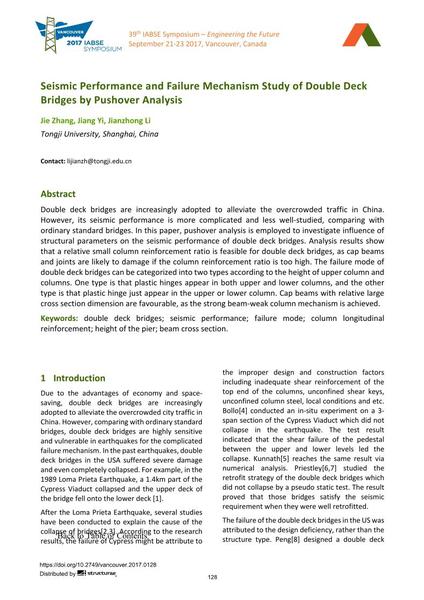Seismic Performance and Failure Mechanism Study of Double Deck Bridges by Pushover Analysis

|
|
|||||||||||
Bibliografische Angaben
| Autor(en): |
Jie Zhang
(Tongji University, Shanghai, China)
Jiang Yi (Tongji University, Shanghai, China) Jianzhong Li (Tongji University, Shanghai, China) |
||||
|---|---|---|---|---|---|
| Medium: | Tagungsbeitrag | ||||
| Sprache(n): | Englisch | ||||
| Tagung: | IABSE Symposium: Engineering the Future, Vancouver, Canada, 21-23 September 2017 | ||||
| Veröffentlicht in: | IABSE Symposium Vancouver 2017 | ||||
|
|||||
| Seite(n): | 128-135 | ||||
| Anzahl der Seiten (im PDF): | 8 | ||||
| Jahr: | 2017 | ||||
| DOI: | 10.2749/vancouver.2017.0128 | ||||
| Abstrakt: |
Double deck bridges are increasingly adopted to alleviate the overcrowded traffic in China. However, its seismic performance is more complicated and less well-studied, comparing with ordinary standard bridges. In this paper, pushover analysis is employed to investigate influence of structural parameters on the seismic performance of double deck bridges. Analysis results show that a relative small column reinforcement ratio is feasible for double deck bridges, as cap beams and joints are likely to damage if the column reinforcement ratio is too high. The failure mode of double deck bridges can be categorized into two types according to the height of upper column and columns. One type is that plastic hinges appear in both upper and lower columns, and the other type is that plastic hinge just appear in the upper or lower column. Cap beams with relative large cross section dimension are favourable, as the strong beam-weak column mechanism is achieved. |
||||
| Stichwörter: |
Versagensart
|
||||
